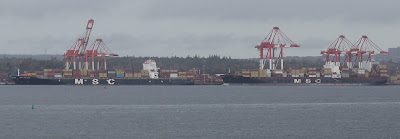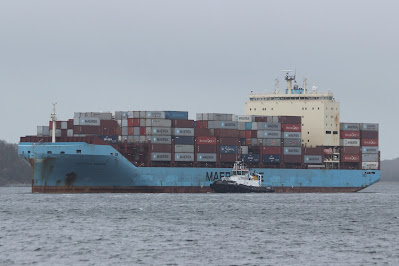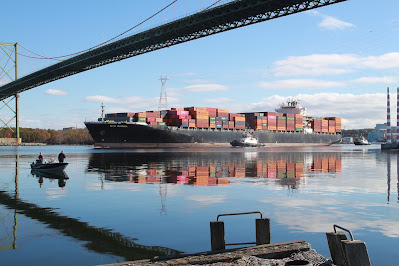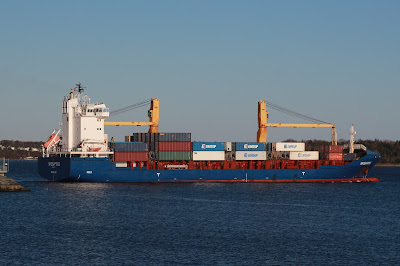A notice appeared in the Halifax Chronicle-Herald newspaper on Saturday, October 22, stating that the Nova Scotia Department of Public Works had deposited with the federal Minister of Transport documents outlining its intention to decommission mechanical components of the East River Crossing PIC178 commonly referred to as the Trenton Lift Bridge. The plan is to "render the bascule functionality totally inoperable while maintaining the roadway." [See Common Project Search Registry, (http://cpc.canada.ca/) registry number 6343.]
The Province requires approval from the federal government under the Canadian Navigable Waters Act to obstruct navigable waters. (I will refrain from detailed comment on the said Act despite it being gutted by a previous government and renamed from the Navigation Protection Act).
The interest to me for this story is that the bridge had a direct connection to the activities of the Halifax Shipyards. (with an "s" - in the plural.) [It is now the singular Halifax Shipyard as the Dartmouth adjunct, the Dartmouth Marine Slips was closed in 2003.]
The East River of Pictou County runs through the early industrial hub of Nova Scotia, from the coal mines of Stellarton, Westville and area through the steel industries in New Glasgow and Trenton. It was also the site of the first steel shipbuilding in Nova Scotia, but due to its shallow water and seasonal nature, it had limitations. (The East River freezes in winter. It flows into Pictou Harbour which also freezes over in winter and was long inaccessible due to ice in the Gulf of St.Lawrence.)
In the late 1960s as Halifax Shipyards embarked on a spree of oil rig construction, the Halifax yards were pressed to be able to fabricate some of the needed components on site. Ownership of Halifax Shipyards had passed from DOSCO to A.V.Roe Canada Ltd in 1957 and to Hawker Siddeley Canada in 1962, along with many other DOSCO assets including steel forging and fabricating plants in Trenton, NS. The "Car Works" in Trenton, builder of rail cars, had the capability of making components, but they would have to be transported to Halifax, and they were too large to be sent by rail.
Hawker Siddeley apparently persuaded the Province of Nova Scotia that a lift bridge across the East River would permit navigation to the Trenton Works and would allow components to fabricated in Trenton and barged to Halifax. (The river was far too shallow for ships.)
The bridge, completed in 1974, allowed for a channel 16m wide. When closed there was a mere 7.6 m clearance beneath the bridge, but when open the only restriction was nearby high voltage transmission power lines at 16 m above water level. The channel depth was 4 m.
In order to facilitate use of the new capability, Halifax Shipyards went shopping and found the right sized barge in the United States. Built in 1949 by John J. Mathis + Co Inc in Camden, NJ it was a 228' x 38' (69.49 m x 11.5 m) craft with a depth of 16'-8" (5.12 m). Originally named the Barrett No.1 the 1262 gt (US measure) vessel was a tank barge, with a ship-like bow, built to carry coal tar (creosote) for its owners. Barrett Co was part of the Allied Chemical Corp and in about 1958 they renamed the barge Allied Chemical No. 11 The barge was used on the US east coast and survived a grounding in Norfolk on December 6, 1954. (The tug Christine Moran was found liable for leaving the barge at anchor - with a barge crew - during a storm).[Allied barges also made trips to the Great Lakes and this one may have seen service there too.]
Dartmouth Marine Slips rebuilt the barge in 1974 by converting it to a deck cargo barge, strengthening the deck, and removing the superstructure. It emerged as Haltren No.1, 1178 gt (Canadian measure).
Legs for the oil rigs were large tubular shapes, and with special deck securement fittings, the barge could carry one quarter the total height of each leg in one trip from Trenton to Halifax.
In operation, the components were loaded aboard the barge in Trenton, and Ferguson Industries' small tugs,the Gulf Spray and Gulf Surgefrom Pictou, would shepherd the barge to the deeper waters of Pictou Harbour. The barge would then be ballasted down to safe seagoing draft and handed over to the tug Point Victor for the tow to Halifax via the Canso Strait.
The sections were transported in a vertical position, but once in
Halifax were lifted off by the crane barge Timberland and landed horizontally on other barges, equipped with special cradles and
moved into position at the building berth.
The Timberland lifts one of the tubular oil rig legs from the Haltren No. 1.
The shipyard acquired several other deck barges in the United States, most of which have never been identified with certainty.
Note in the background of this photo, the Volvo car assembly plant at Pier 9, with the tug W.N.Twolan from Churchill, MB, wintering over, and in the middle ground behind Haltern No.1 what is likely the old canaller Birchton used by the yard as a pontoon, and several other of those unidentified scows.
When the oil rig program ended Hawker Siddeley hung on to the barge for a few years, but in the early 1980s sold it to Techno-Maritime Ltée of Quebec City. Techno kept the Halifax Trenton name but put it to work carrying pulpwood from Port Menier, Anticosti, Island. On October 25, 1995 the barge, in ballast, broke free from the tug Techno-St-Laurent (ex CNAV Birchton) and stranded west of Southwest Point, Anticosti. The barge was declared a constructive total loss and an extensive clean up ensued due to large quantities of oily waste in the bilges, which was more or less completed in 1996 [see reference cited below]. A plan to retrieve the barge in 1996 was abandoned, as there was still oily waste in the hull. As far as I know the barge is still there, but by now no doubt badly deteriorated. Its papers were apparently never surrendered and as a result it remained on the Registry books until its registration was suspended on March 10, 2018.
As for the Trenton bridge, it has seldom been raised since those days, and pleasure craft are the only vessels to be seen on the East River. The NS DPW states in their submission that the bridge has no dedicated operator and has been inoperable for "the past number of years."
The rolling bascule type bridge was invented by Sherzer Rolling Lift Bridges of Chicago, later succeeded by Hazelet and Erdal Engineers, and scores were built in locations in the US and Canada and overseas. Their components are complex and do require active maintenance. Many have been made inoperable in recent years - most in the down position, such as the Third Street (1931) and Fifth Street (1961) bridges in Chatham-Kent, ON [I attended the street dance on the latter when it opened on Labour Day 1961. It was one of the first integrated public dances in Chatham - hard to believe!].
Another bascule bridge, although operable, is left in the up position except in case of emergency. It is on rue Dalhousie in the Old Port of Quebec and crosses the lock between the outer Bassin Louise and the inner tidal Bassin Louise. (It is visible on the Quebec Port live cam.)
References: See the Ship Source Oil Pollution Fund Annual Report 1997-1998 for excellent photos of the grounded barge: SOPF Report
I have seen one other photo on line, taken in 2007 (and unfortunately misidentified) still with the large letters "Techno" on the sides. It can be found by Googling "Anticosti Shipwreck".
.






















.JPG)





































.JPG)